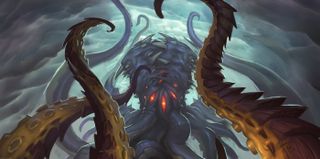Why Hearthstone in 2016 was actually pretty great (despite all the Shaman)
Sottle rounds up the most memorable moments of the year, and then Yogg deletes his work and makes him start again.

As we near the end of the Year of the Kraken—did anyone actually call it that? Do we even still remember that it’s a thing?—the Hearthstone community can look back on 2016 and safely say it was a massive year for the game. We saw changes that affected everyone, from the most casual players up to the most competitive pros. Yes, there was the madness of Yogg and the crushing dominance of Midrange Shaman, (don’t worry, we’ll get to those), but on the whole 2016 delivered great memories and glorious memes. Here’s what stood out most for me…
Esports comes of age but a sheep steals the show
The Hearthstone Championship Tour format took a massive step forward in 2017. By switching to a year-long tournament circuit, Blizzard enabled storylines to develop around lesser known players. In the process many new stars were made, including Dr. Hippi, Amnesiac (AKA The Yung Savage—note there’s no ‘o’, Blizzard), and of course the new world champion Pavel.
The whole setup had a much more legitimate, professional feel, though that isn’t to say the competitive scene was perfect. Players cried out for Swiss all year (and will be getting it in 2017), open cups felt like a matter of willingness to grind rather than a testament of skill, and some of the HCT events were played in the most stale of metagames. The important thing is that lessons were learned and the plans for 2017 are aiming to fix most of these issues.

The HCT circuit also threw up a lot of memorable moments. AKA Wonder’s incredible war cry as he sealed his finals spot, HotMEOWTH’s brave/insane decision to bring the Blood Warrior deck that would eventually be his downfall, and the Yoggs… Oh, the Yoggs. But the standout was of course the Pavelling Book.
I don’t want to go as far as to say that big RNG moments define Hearthstone as a spectator activity, but click the link and listen to that crowd. Casting live at BlizzCon really crystallized the perspective of the casual viewer in my mind. There were so many incredible skill-based moments in the World Championship that were met with the equivalent of crickets from the crowd. But the lucky Ragnaros flips and that noise that went up when Pavel’s Polymorph appeared? Pandemonium.
It’s worth remembering that for every one of us who wants to see cards like Yogg, Babbling Book and Imp-losion nuked from orbit (and I do very much include myself here), there are hundreds of thousands of viewers who feed on such moments, and those people keep the game vibrant. Even for a miserly old sourpuss like me, that lucky sheep will go down in history and be with me for as long as I walk this earth.

Standard brings the new hotness
The start of 2016 introduced a largely unprecedented concept in terms of Hearthstone’s design philosophy: Changing a lot of cards at once. Previously, Team 5 had been more careful with nerfs than Kobolds are with candles, but to lay the ground for the first Standard rotation the designers unleashed an unprecedented wave of adjustments that gave us hope that they would continue to tweak power levels throughout the year.
PC Gamer Newsletter
Sign up to get the best content of the week, and great gaming deals, as picked by the editors.
The demise of the face-loving Leper Gnome gave control fanatics brief hope that aggro might struggle.
While that hasn’t been the case, combined with the new set’s arrival and huge swathes of cards leaving Standard simultaneously, it gave us a huge metagame shake-up. The Force of Nature-Savage Roar combo bit the dust and briefly left Druid floundering for an effective play style, and the demise of the face-loving Leper Gnome gave control fanatics even briefer hope that aggro might struggle. At Dreamhack Austin—the major tournament that immediately followed Standard’s arrival—excitement abounded with new deck archetypes as far as the eye could see. To add to the surreal air, after so many near misses Chakki walked away the winner with a control-heavy line-up.
The sets that have followed Whispers of the Old Gods can best be described as hit and miss. One Night in Karazhan was largely underwhelming and ushered in a period of absolute Shaman dominance due to the inexplicable decision to give Thrall the Spirit Claws weapon. Very few classes got anything approaching the power level of the new Shaman cards, and so the era of Shamanstone was upon us.
Salvation was finally found on the Mean Streets of Gadgetzan, which threw another grenade amongst the pigeons. Say what you will about the current power of aggro decks (and who could have predicted that?), but the ladder is packed with new decks. This is better than a situation where players think: “Hey, this new card is sweet, I’ll just add it to my existing tier one deck”.
Mean Streets cards were strong enough to birth new archetypes like Kun Combo Druid, Jade Shaman, various Reno decks, and bring about the rebirth of Pirate Warrior and Dragon Priest. Even Miracle Rogue is back with a new eyepatch-wearing bang. Overall then, a solid 4 Mana 7/7 out of 10 for card releases. No, I have no idea what I mean there either.
Ekop finally wins a major and trolls everyone

The self-proclaimed "best Hearthstone player in the world".
Much like Chakki, Ekop is a player who has been around since competitive Hearthstone’s inception, and has consistently put in solid tournament showings without ever taking home a big one. This gave birth to the Reynad-crafted meme of “Ekop’s in everything”, due to Ekop always receiving invites to big events without ever winning them.
In 2016, Ekop finally laid the hoodoo to rest with his triumph at Insomnia against a stacked field of the best players from Europe and beyond. In classic Ekop fashion, the master troll was not going to let the moment pass unmarked, so he bluffed playing Yogg despite having lethal on board—much to the anguish of the crowd, including yours truly on the mic.
Lifecoach proves das haus always wins
When he wasn’t spending 10 hours a day grinding the best decks with SuperJJ, Lifecoach still had time to return to his gambling roots by making a series of novelty bets with other top Hearthstone players. The first and most memorable of these was his wager against teammate Thijs, who he raced to legend with a terrifying bungee jump for the loser on the line.
This whole event was Hearthstone at its most fun: a stream-driven event that engaged viewers and had amusing consequences. Despite being the underdog in most people’s eyes due to his slow playing “Ropecoach” reputation, Lifecoach emerged victorious and packed Thijs off to face his fears. They covered the day together in a vlog, which is a great watch, if not for the jump itself, then purely for Lifecoach’s wonderful “it doesn’t seem like you can die” psych out.
The trend continued with Freeze Mage overlord Laughing losing his hair to Lifecoach, and further wagers with StanCifka and Ostkaka over winrates at events. Maybe one day people will learn that you don’t take on the master at his own game, but for now, it seems like Lifecoach’s reign of terror will continue.
To Yogg or not to Yogg?
It would be remiss of me not to give airtime to the tentacled terror. Outside of Midrange Shaman during the post-Karazhan, nothing defined the meta this year more than Yogg-Saron, Hope’s End. Everything from casual ladder games to HCT deciders were decided by the equivalent of a Chess player flipping the board and then having a drunk chimp reposition the pieces.
[Yogg was] the equivalent of a Chess player flipping the board and then having a drunk chimp reposition the pieces.
It was awful while it lasted, (or amazing, as far as degenerates were concerned), but thankfully Blizzard eventually intervened with a surprisingly balanced and considered nerf. The card was still playable, it still did the nonsense things that some people love, but it was enough to eventually force it out of the competitive format. There was a period where I would wake up in a cold sweat thinking about the possibility of a high roll Yogg deciding a series at BlizzCon while I was casting, but thankfully, no such insane moments of RNG took place. Baaaaaaaa.
Of course this list is not definitive, and the honorable mentions could fill another article or two. It’s worth nothing the TerrenceM controversy at Dreamhack Austin, which led to a debate over the role of Twitch chat in competitive events, and contributed in no small part to Twitch’s new moderation tools. Other notables include the Batstone tournament, which was a resounding success, giving us a great mix of fun format and high level play. Thijs repeating as Europe Champion was also glowing testimony to his skill and workrate, which he has maintained despite his growing success as a streamer.
People also spent quite a lot of time being really upset about Purify and the state of Priest. But to end on a positive, let’s pay tribute to SuperJJ, who rose to prominence as an absolute top tier player, capitalising on his breakout in late 2015.
Let me know what I missed in the comments or on Twitter. Until next year travellers, well met!
Most Popular



